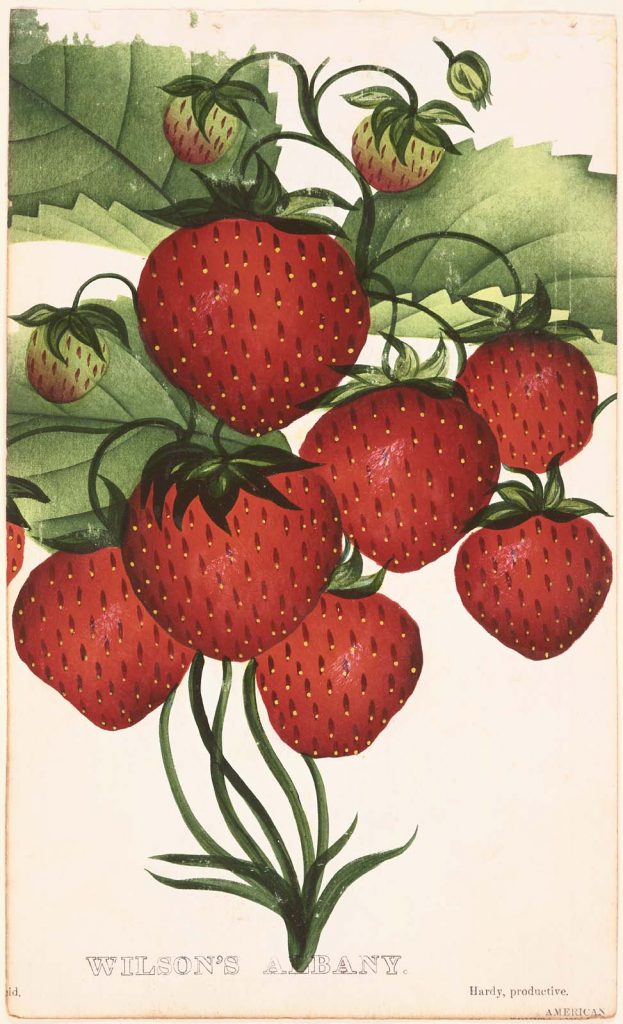
Once upon a time, nearly every strawberry in the United States was an Albany strawberry. First cultivated by James Wilson at his nursery, “situated at the head of Lydius-street, within three-quarters of a mile of the City Hall,” his strawberry became the dominant breed for decades.
For details, we turn to Stevenson Whitcomb Fletcher’s “The Strawberry in North America: History, Origin, Botany, and Breeding.” Fletcher tells us that before Wilson came along, commercial strawberries were an insignificant industry, occupying less than 1500 acres; Wilson popularized the strawberry for the home garden and for an agricultural industry that grew to 150,000 acres, beginning with his sowing seed of three popular garden varieties in 1851. “The seeds were the result of natural pollination; no hand crossing was done.” At a meeting of the Albany and Rensselaer Horticultural Society in Albany on June 22, 1853, Wilson exhibited a new seedling strawberry, but it did not receive much attention until the next year.
“The following summer James Wilson showed a number of potted plants of his seedling, each laden with fruit. There was no lack of appreciation then. In the words of a current publication, ‘Such was the size and number of the berries upon each plant that people were astonished, curiosity was excited, and public attention was aroused to an examination of the claims of this new strawberry.’ It was then named Wilson’s Albany.” Wilson died in 1855, leaving the nursery to his son John, who saw the rise of the Wilson’s Albany. “By 1861 it had largely superseded all other sorts for market purposes, although the Hovey and Large Early Scarlet persisted for some years, the former near Boston, the latter in western New York, where it vied with Wilson as late as 1864. The Wilson completely dominated the markets of the United States and Canada from 1860 to 1880.” It was estimated that in 1872, the Wilson comprised more than 90 percent of the strawberries in cultivation. Strawberry Fever swept the country between 1858 and 1870, Fletcher says.
“Strawberries commonly sold for thirty to forty cents a quart, and profits of $1000 an acre were not unusual. In 1861 Joseph Harris, editor, editor of the Genesee Farmer, visited Bloomington, Illinois, and found Wilson strawberries selling at fifteen cents a quart, and corn at eight cents a bushel. People who had never before grown strawberries, or any other kind of fruit – merchants, grain and stock farmers, professional men – rushed into the strawberry business.”
Charles Hovey, the Boston area grower, did not take this affront to his former dominance lying down. In 1860, he declared that Wilson’s Albany was “one of the sourest, most dirty colored, and most disagreeable flavored of all recently introduced sorts – an excellent sort to make vinegar of. Besides, it is soft, watery, unfit for carriage, has a very large calyx, and is hollow at the core.” If that weren’t enough, the Massachusetts Horticultural Society called it unfit for general cultivation.
“Boston never ceased to look upon the Wilson with a jaundiced eye. When her sons journeyed southward in 1861, and were forced by dire hunger to partake of the despised fruit, one of the survivors declared, ‘The Wilson strawberry killed more Boston men during the war than Confederate bullets.’”
The complaints weren’t without merit. It was so popular partly for its dependability – it produced large crops without much care. It was firm, and could be shipped easily under the “trying conditions of transportation and marketing that prevailed then.” It did not require professional gardening to grow, and was easy for anyone to cultivate. But it was not sweet. In fact, it was sour. Henry Ward Beecher said “It has every quality of excellent except in the matter of eating.” Nevertheless, the Wilson dominated as a commercial variety for 20 years. Other varieties, including the Crescent and the Sharpless, joined it in commercial dominance, and those three varieties were nearly every strawberry commercially grown for some period of time. Eventually, they were overshadowed by other breeds, and Wilson’s Albany became a memory.
Need more detail on Wilson’s strawberry? AllOverAlbany has it.

Leave a Reply